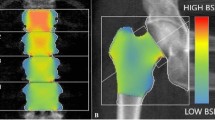Abstract
The bone density (BMD) is a medical term normally referring to the amount of mineral matter per square centimetre of bones. Twenty-five patients (18 female and 7 male patients with a mean age of 71.3 years) undergoing both lumbar spine DXA scans and computed tomography imaging were evaluated to determine if HU correlates with BMD and T-scores. BMD is used in clinical medicine as an indirect indicator of osteoporosis and fracture risk. This medical bone density is not the true physical “density” of the bone, which would be computed as mass per volume. Dual-energy X-ray absorptiometry (DXA, previously DEXA), a means of measuring BMD, is the most widely used and most thoroughly studied bone density measurement technologies. Different types of bone strength are required for various applications, but this strength calculation requires different machines for each strength property or it is done by different software like X-ray, CT scan, DEXA and BIA. The paper includes the design of an experimental setup which performs different types of test like tension, compression, three point bending, four point bending and torsion. The modified correlation between BMD and HU for various strength calculations is found out and validated with the experimental results.










Similar content being viewed by others
References
Cesar Libanati, Klaus Engelke and Huei Wang 2009 Quantitative computed tomography (QCT) of the forearm using general purpose spiral whole-body CT scanners: Accuracy, precision and comparison with dual-energy X-ray absorptiometry (DXA). Synarc Inc., San Francisco, USA, and Hamburg, Germany, Institute of Medical Physics, University of Erlangen, Germany, Amgen Inc., Thousand Oaks, CA, USA, University of California, San Francisco, USA
Cristofolini L, Cappello A, Mc Namara B P and Viceconti M 2006 A minimal parametric model of the femur to describe axial elastic strain in response to loads. Med. Eng. Phys. 18(6): 502–514; 1996, 90–98
Damien Subit, Eduardo del Pozo de Dios, Juan Velazquez- Ameijide, Carlos Arregui Dalmasesa and Jeff Crandall 2013 Tensile material properties of human rib cortical bone under quasi-static and dynamic failure loading and influence of the bone microstructure on failure characteristics. Phys. Biophys. pp 1–22
Hanumantharaju H G and Shivanand H K 2. Strength analysis & comparison of SS316L, Ti-6AI-4V & Ti-35Nb-7Zr-5Ta used as orthopaedic implant materials by FEA. In: 2nd international conference on chemical, biological and environmental engineering (ICBEE 2010)
Lengsfeld M, Kaminsky J, Merz B and Franke R P 1996 Sensitivity of femoral strain pattern analyses to resultant and muscle forces at the hip joint. J. Med. Eng. Phys. 18(1): 70–78
Patil B R, Patkar D P, Mandlik S A, Kuswarkar M M and Jindal G D 2012 Estimation of bone mineral content from bioelectrical impedance analysis in Indian adults aged 23–81 years: A comparison with dual energy X-ray absorptiometry. Int. J. Biomed. Eng. Technol. 8 (1)
Raymond E Cole, DO, CCD 2008 Improving clinical decisions for women at risk of osteoporosis: Dual femur bone mineral density testing, vol.108.
Rho J Y, Hobatho M C and Ashman R B 1995 Relations of mechanical properties to density & CT numbers in human bones. Med. Eng. Phys. 17(5): 347–355
Rodríguez Lelis J M, Marciano Vargas Trevino, Navarro Torres J, Arturo Abundez P, Sergio Reyes Galindo and Dagoberto Vela Arvizo 2007 A qualitative stress analysis of a cross section of the trabecular bone tissue of the femoral head by photoelasticity. Revista Mexicana De Ingeniería Biomédica Xxviii (2): 105–109
Yuehuei H An and Robert A Draughn 2000 Mechanical testing of bone and the bone-implant interface. CRC Press, Washington, PP. 3–219
Author information
Authors and Affiliations
Corresponding author
Rights and permissions
About this article
Cite this article
KHAN, S.N., WARKHEDKAR, R.M. & SHYAM, A.K. Analysis of bone mineral density of human bones for strength evaluation. Sadhana 40, 1667–1679 (2015). https://doi.org/10.1007/s12046-015-0368-4
Received:
Revised:
Accepted:
Published:
Issue Date:
DOI: https://doi.org/10.1007/s12046-015-0368-4




